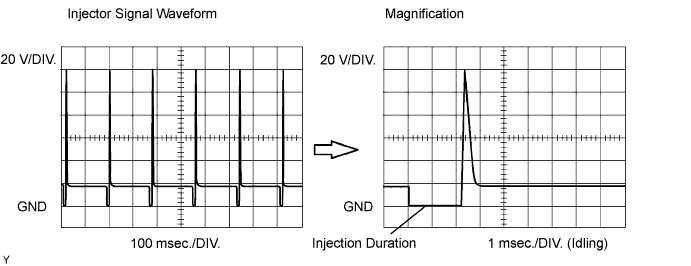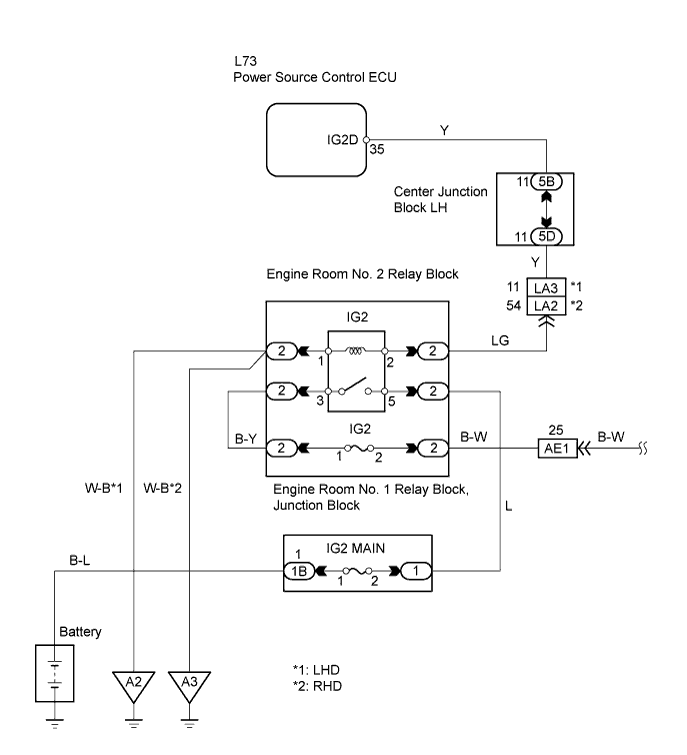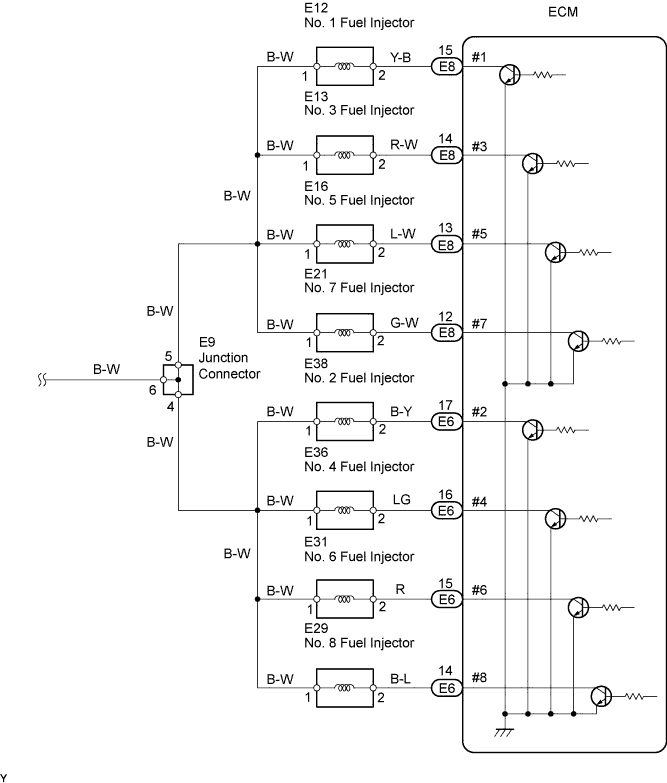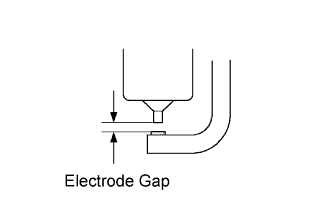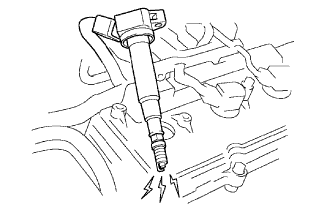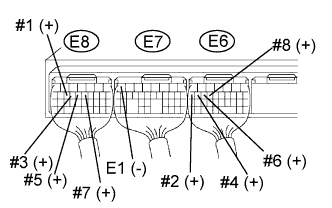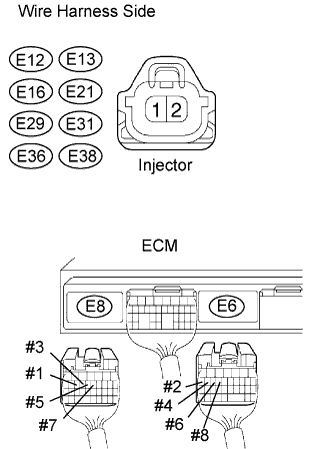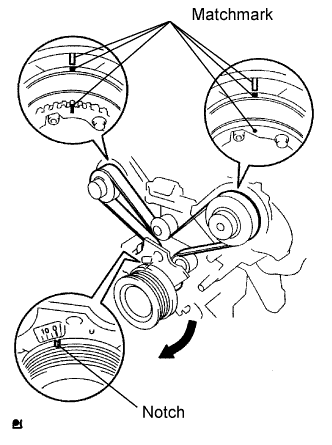Engine. Lexus Gs430, Gs300. Uzs190 Grs190
DESCRIPTION
MONITOR DESCRIPTION
WIRING DIAGRAM
CONFIRMATION DRIVING PATTERN
INSPECTION PROCEDURE
CHECK OTHER DTC OUTPUT
CHECK MISFIRE RPM AND MISFIRE LOAD
CHECK CONNECTION OF PCV HOSE
CHECK MISFIRE COUNT (CYL #1, #2, #3, #4, #5, #6, #7, #8)
PERFORM ACTIVE TEST (FUEL CUT #1 TO #8)
INSPECT SPARK PLUG
CHECK SPARK AND IGNITION
CHECK CYLINDER COMPRESSION PRESSURE ON MISFIRING CYLINDER
CHANGE NORMAL SPARK PLUG AND CHECK SPARK OF MISFIRING CYLINDER
CHECK ECM (#1, #2, #3, #4, #5, #6, #7, #8 VOLTAGE)
CHECK WIRE HARNESS (INJECTOR - ECM)
CHECK FUEL INJECTOR OF MISFIRING CYLINDER
CHECK VALVE CLEARANCE OF MISFIRING CYLINDER
CHECK AIR INDUCTION SYSTEM
CHECK VALVE TIMING
CHECK FUEL PRESSURE
READ DATA LIST (COOLANT TEMP)
READ DATA LIST (MAF)
DTC P0300 Random / Multiple Cylinder Misfire Detected |
DTC P0301 Cylinder 1 Misfire Detected |
DTC P0302 Cylinder 2 Misfire Detected |
DTC P0303 Cylinder 3 Misfire Detected |
DTC P0304 Cylinder 4 Misfire Detected |
DTC P0305 Cylinder 5 Misfire Detected |
DTC P0306 Cylinder 6 Misfire Detected |
DTC P0307 Cylinder 7 Misfire Detected |
DTC P0308 Cylinder 8 Misfire Detected |
DESCRIPTION
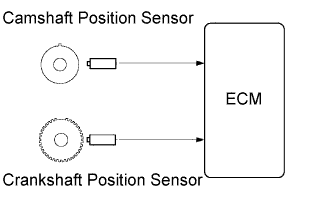
- When a misfire occurs in the engine, hydrocarbons (HC) enter the exhaust in high concentrations. If the HC concentration is too high, exhaust emission levels may increase. High concentrations of HC can also cause the temperature of the catalyst to increase, possibly damaging the catalyst. To prevent the increase in emissions and limit the possibility of thermal damage, the ECM monitors the misfire rate. When the temperature of the catalyst reaches a point of thermal degradation, the ECM will begin flashing the MIL. For monitoring misfires, the ECM uses both the camshaft position sensor and the crankshaft position sensor. The camshaft position sensor is used to identify misfiring cylinders and the crankshaft position sensor is used to measure variations in the crankshaft rotation speed. The misfire counter records how many times the crankshaft rotation speed variations exceed threshold values.
If the misfiring rate exceeds the threshold value and could cause emissions to deteriorate, the ECM illuminates the MIL and sets a DTC.
DTC No.
| DTC Detection Condition
| Trouble Area
|
P0300
| Misfiring of random cylinder is detected
| - Ignition coil
- Fuel injector
- Fuel pressure
- Compression pressure
- Valve timing
- Valve clearance
- Vacuum hose
- PCV hose
- Air induction system
- Exhaust system
- ECM
|
P0301
P0302
P0303
P0304
P0305
P0306
P0307
P0308
| Misfiring of each cylinder is detected
| Same as DTC No. P0300
|
- HINT:
- In some cases, several DTCs for misfired cylinders (DTCs P0301 to P0308) are recorded but the random/multiple cylinder misfire DTC (P0300) is not recorded. This is an indication that the misfires were detected and recorded at different times. Random misfire codes are recorded only when several misfires occur at the same time.
- Reference: Inspection using an oscilloscope.
- With the engine idling, check the waveform between terminals #1 to #8 and E1 of the ECM connectors.
- The correct waveform is as shown.
MONITOR DESCRIPTION
The ECM illuminates the MIL as follows (2 trip detection logic is used and DTC is stored after 2 trip detection):- The misfiring rate exceeds a threshold value and could cause emissions to deteriorate.
- During the first 1,000 crankshaft revolutions after engine starts, an excessive misfire rate (approximately 20 to 50 misfires per 1,000 crankshaft revolutions) occurs once.
- An excessive misfire rate (approximately 20 to 60 misfires per 1,000 crankshaft revolutions) occurs 4 times.
The ECM begins flashing the MIL as follows (2 trip detection logic is used and DTC is stored after 2 trip detection):- Within 200 crankshaft revolutions at a high rpm, the threshold for "percent of misfires causing catalyst damage" is reached once.
- Within 200 crankshaft revolutions at a normal rpm, the threshold for "percent of misfires causing catalyst damage" is reached 3 times.
WIRING DIAGRAM
CONFIRMATION DRIVING PATTERN
- Connect the intelligent tester to the DLC3.
- Record the DTC and freeze frame data.
- Set check mode on the intelligent tester (Click here).
- Read the value on the misfire counter for each cylinder when idling. If the value is displayed on the misfire counter, skip the following confirmation driving procedure.
- Drive the vehicle several times while using the Data List's Misfire RPM and Misfire Load menu items to keep track of the vehicle's engine speed, load and its surrounding range.
If you have no intelligent tester, turn the engine switch off after the symptom is simulated once. Then repeat the simulation process.
- HINT:
- In order to force output of the DTC, it is necessary to drive with Misfire RPM and Misfire Load selected in the Data List for the period of time in the chart below. Do not turn the engine switch off. Turning the engine switch off switches the diagnosis system from check mode to normal mode and all DTCs, freeze frame data and other data are erased.
Engine RPM
| Time
|
Idling
| 3.5 minutes or more
|
1,000 rpm
| 3 minutes or more
|
2,000 rpm
| 1.5 minutes or more
|
3,000 rpm
| 1 minute or more
|
- Check if a misfire occurs by monitoring DTC output and the freeze frame data. Then, record the DTCs, freeze frame data and misfire counter data.
- Turn the engine switch off and wait for at least 5 seconds.
INSPECTION PROCEDURE
- HINT:
- If DTCs other than misfire DTCs are output simultaneously, troubleshoot the non-misfire DTCs first.
- Read freeze frame data using the intelligent tester. Freeze frame data records the engine conditions when a malfunction is detected. When troubleshooting, freeze frame data can help determine if the vehicle was running or stopped, if the engine was warmed up or not, if the air-fuel ratio was LEAN or RICH, and other data from the time the malfunction occurred.
- If the misfire does not occur when the vehicle is brought to the workshop, the misfire can be confirmed by reproducing the conditions recorded in the freeze frame data. Also, after finishing repairs, confirm that no misfire occurs (see confirmation driving pattern).
- On 6 and 8 cylinder engines, cylinder-specific misfire fault codes are disabled at high engine speeds.
If the misfire starts in a high engine speed range or the misfire occurs only in a high engine speed area, only general fault code P0300 will be stored.
When only P0300 is stored:
- Erase the general misfire fault code from the intelligent tester.
- Start the engine and drive the confirmation pattern (see confirmation driving pattern).
- Read the value of the misfire ratio for each cylinder. Or, check if a DTC was output.
- Perform repairs on the cylinder that has a high misfire ratio. Or repair the cylinder indicated by any output DTCs.
- After finishing repairs, drive the confirmation pattern again and confirm that no misfire occurs.
- If either Short FT #1, Long FT #1, Short FT #2 or Long FT #2 in the freeze frame data is +-20%, there is a possibility that the air-fuel ratio is becoming RICH (-20% or less) or LEAN (+20% or more).
- When Coolant Temp in the freeze frame data is less than 75°C (167°F), a misfire is only possible during engine warm-up.
- If the misfire cannot be reproduced, the cause may be: 1) low fuel in the vehicle, 2) improper fuel in the vehicle, 3) a contaminated ignition plug, or 4) another problem.
- Be sure to check the value on the misfire counter after repairs.
Connect the intelligent tester to the DLC3.
Enter the following menus: Powertrain / Engine / DTC.
Read the DTCs.
- Result:
Display (DTC output)
| Proceed to
|
P0300, P0301, P0302, P0303, P0304, P0305, P0306, P0307 or P0308
| A
|
P0300, P0301, P0302, P0303, P0304, P0305, P0306, P0307 or P0308 and other DTCs
| B
|
| 2.CHECK MISFIRE RPM AND MISFIRE LOAD |
Read and note the Misfire RPM and the Misfire Load (engine load) with the Data List.
- HINT:
- The Misfire RPM and Misfire Load displays have vehicle data that can help lead to successful repairs of any misfiring cylinders.
| 3.CHECK CONNECTION OF PCV HOSE |
- OK:
- PCV hose is connected correctly and is not damaged.
| | REPAIR OR REPLACE PCV HOSE |
|
|
| 4.CHECK MISFIRE COUNT (CYL #1, #2, #3, #4, #5, #6, #7, #8) |
Clear the DTCs.
Enter the following menus: Powertrain / Engine / Data List / Primary / Cylinder #1 (to #8) Misfire Rate.
Allow the engine to idle.
Read the misfire count of the cylinders #1 to #8.
If no misfire is counted for all of the cylinders, move the shift lever into the D position and repeat the 2 previous steps.
If misfires are still not counted, perform the next 2 steps.
Drive the vehicle with Misfire RPM and Misfire Load selected in the Data List.
Read the misfire count of cylinders #1 to #8, or check for any output DTCs.
- Result:
Misfire count in each cylinder
| Proceed to
|
1 or 2 cylinders have some misfire counts
| A
|
3 cylinders or more have some misfire counts
| B
|
- HINT:
- If it is difficult to reproduce misfires for each cylinder, check the Data List item called Misfire Margin. Try to find vehicle driving conditions that lower the Misfire Margin value. Values above 30% are considered normal.
- If the freeze frame data's record of the ECT is below 75°C (167°F), the misfire may be detected only when the engine is cold.
- If the freeze frame data's record of the Engine Run Time is below 120 seconds, the misfire may be detected right after the engine is started.
| 5.PERFORM ACTIVE TEST (FUEL CUT #1 TO #8) |
Allow the engine to idle.
Enter the following menus: Powertrain / Engine / Active Test / Control the Cylinder #1 (to #8) Fuel Cut.
If a cylinder has a high misfire count, cut fuel to the cylinder. Compare the misfire count of the cylinder before fuel cut and after fuel cut.
- Result:
Misfire count in each cylinder
| Proceed to
|
Misfire count of the cylinder before fuel cut and after fuel cut are roughly the same
| A
|
Misfire count of the cylinder before fuel cut is lower than after fuel cut
| B
|
- HINT:
- If the misfire count of the cylinder before fuel cut and after fuel cut are roughly the same, the cylinder is misfiring.
- If the misfire count of the cylinder before fuel cut is lower than after fuel cut, the cylinder misfires sometimes.
- NOTICE:
- This Active Test cannot be performed while the vehicle is being driven.
Remove the engine cover.
Remove the ignition coil and the spark plug of the misfire cylinder.
Measure the spark plug electrode gap.
- Standard:
- The electrode gap is 1.0 to 1.3 mm (0.039 to 0.051 in.)
Check the electrode for carbon deposits.
- Recommended spark plug:
Manufacturer
| Spark Plug Type
|
DENSO
| SK20R11
|
NGK
| IFR6A11
|
- NOTICE:
- If the electrode gap is larger than the standard, replace the spark plug. Do not adjust the electrode gap.
| 7.CHECK SPARK AND IGNITION |
Disconnect the injector connectors to prevent the engine from starting.
Install the spark plug to the ignition coil.
Attach the spark plug to the cylinder head cover.
Crank the engine for 2 seconds or less and check if a spark occurs.
- OK:
- Spark occurs.
| 8.CHECK CYLINDER COMPRESSION PRESSURE ON MISFIRING CYLINDER |
Measure the cylinder compression pressure of the misfiring cylinder.
| NG |
|
|
|
| CHECK ENGINE TO DETERMINE CAUSE OF LOW COMPRESSION |
|
| 9.CHANGE NORMAL SPARK PLUG AND CHECK SPARK OF MISFIRING CYLINDER |
For inspection purposes, remove the current spark plug and install a normally functioning spark plug.
Perform a spark test.
- CAUTION:
- Always disconnect each injector connector.
- NOTICE:
- Do not crank the engine for more than 2 seconds.
Install the spark plug to the ignition coil and connect the ignition coil connector.
Disconnect the injector connector.
Ground the spark plug.
Check if a spark occurs while the engine is being cranked.
- OK:
- Spark jumps across electrode gap.
| NG |
|
|
|
| REPLACE IGNITION COIL (THEN CONFIRM THAT THERE IS NO MISFIRE) |
|
| 10.CHECK ECM (#1, #2, #3, #4, #5, #6, #7, #8 VOLTAGE) |
Turn the engine switch on (IG).
Measure the voltage of the ECM connectors.
- Standard voltage:
Tester Connection
| Specified Condition
|
E8-15 (#1) - E6-7 (E1)
| 9 to 14 V
|
E6-17 (#2) - E6-7 (E1)
| 9 to 14 V
|
E8-14 (#3) - E6-7 (E1)
| 9 to 14 V
|
E6-16 (#4) - E6-7 (E1)
| 9 to 14 V
|
E8-13 (#5) - E6-7 (E1)
| 9 to 14 V
|
E6-15 (#6) - E6-7 (E1)
| 9 to 14 V
|
E8-12 (#7) - E6-7 (E1)
| 9 to 14 V
|
E6-14 (#8) - E6-7 (E1)
| 9 to 14 V
|
| | CHECK FUEL INJECTOR OF MISFIRING CYLINDER |
|
|
| 11.CHECK WIRE HARNESS (INJECTOR - ECM) |
Disconnect the connector of the misfire cylinder and the E6 and E8 ECM connectors.
Turn the engine switch on (IG).
Measure the resistance and voltage of the wire harness side connectors.
- Standard voltage:
Cylinder
| Tester Connection
| Specified Condition
|
No. 1
| E12-1 - Ground
| 11 to 14 V
|
No. 2
| E38-1 - Ground
| 11 to 14 V
|
No. 3
| E13-1 - Ground
| 11 to 14 V
|
No. 4
| E36-1 - Ground
| 11 to 14 V
|
No. 5
| E16-1 - Ground
| 11 to 14 V
|
No. 6
| E31-1 - Ground
| 11 to 14 V
|
No. 7
| E21-1 - Ground
| 11 to 14 V
|
No. 8
| E29-1 - Ground
| 11 to 14 V
|
- Standard resistance:
Cylinder
| Tester Connection
| Specified Condition
|
No. 1
| E12-2 - Ground
| 10 kΩ or higher
|
No. 1
| E12-2 - E8-15 (#1)
| Below 1 Ω
|
No. 2
| E38-2 - Ground
| 10 kΩ or higher
|
No. 2
| E38-2 - E6-17 (#2)
| Below 1 Ω
|
No. 3
| E13-2 - Ground
| 10 kΩ or higher
|
No. 3
| E13-2 - E8-14 (#3)
| Below 1 Ω
|
No. 4
| E36-2 - Ground
| 10 kΩ or higher
|
No. 4
| E36-2 - E6-16 (#4)
| Below 1 Ω
|
No. 5
| E16-2 - Ground
| 10 kΩ or higher
|
No. 5
| E16-2 - E8-13 (#5)
| Below 1 Ω
|
No. 6
| E31-2 - Ground
| 10 kΩ or higher
|
No. 6
| E31-2 - E6-15 (#6)
| Below 1 Ω
|
No. 7
| E21-2 - Ground
| 10 kΩ or higher
|
No. 7
| E21-2 - E8-12 (#7)
| Below 1 Ω
|
No. 8
| E29-2 - Ground
| 10 kΩ or higher
|
No. 8
| E29-2 - E6-14 (#8)
| Below 1 Ω
|
| | REPAIR OR REPLACE HARNESS AND CONNECTOR |
|
|
| 12.CHECK FUEL INJECTOR OF MISFIRING CYLINDER |
| 13.CHECK VALVE CLEARANCE OF MISFIRING CYLINDER |
| 14.CHECK AIR INDUCTION SYSTEM |
| | REPAIR OR REPLACE AIR INDUCTION SYSTEM |
|
|
Remove the engine cover.
Remove the drive belt.
Remove the timing belt cover LH and RH.
Turn the crankshaft to align the matchmarks of the crankshaft.
Align the notch of the crankshaft pulley with the "0" position.
Confirm whether the matchmarks of the camshaft pulley and cylinder head cover are facing each other.
If the matchmarks are not facing each other, turn the crankshaft clockwise by 360°. Confirm again if the matchmarks are facing each other.
- OK:
- The matchmarks of the camshaft pulley and the cylinder head cover face each other when the notch of the crankshaft pulley is in the "0" position.
| | CHECK AND REPLACE FUEL PUMP, PRESSURE REGULATOR, FUEL PIPE LINE AND FILTER |
|
|
| 17.READ DATA LIST (COOLANT TEMP) |
Connect the intelligent tester to the DLC3.
Enter the following menus: Powertrain / Engine / Data List / Primary / Coolant Temp.
Read the Coolant Temp value when the engine is cold and warmed up.
- Standard:
- ECT when the engine is cold: Same as ambient temperature
ECT when the engine is warmed up: 75 to 95°C (167 to 203°F)
| | REPLACE ENGINE COOLANT TEMPERATURE SENSOR |
|
|
Enter the following menus: Powertrain / Engine / Data List / Primary / Coolant Temp and MAF.
Allow the engine to idle until the ECT reaches 75°C (167°F).
Read the MAF value at idle rpm and 3,000 rpm.
- Standard:
- MAF at idle rpm: 3 to 6 g/s (shift lever is in N position and A/C is OFF)
MAF at 3,000 rpm: 11 to 23 g/s (shift lever is in N position and A/C is OFF)
| | REPLACE MASS AIR FLOW METER |
|
|
| OK |
|
|
|
| CHECK FOR INTERMITTENT PROBLEMS |
|

